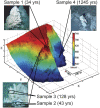Archaea and bacteria with surprising microdiversity show shifts in dominance over 1,000-year time scales in hydrothermal chimneys
- PMID: 20080654
- PMCID: PMC2824366
- DOI: 10.1073/pnas.0905369107
Archaea and bacteria with surprising microdiversity show shifts in dominance over 1,000-year time scales in hydrothermal chimneys
Abstract
The Lost City Hydrothermal Field, an ultramafic-hosted system located 15 km west of the Mid-Atlantic Ridge, has experienced at least 30,000 years of hydrothermal activity. Previous studies have shown that its carbonate chimneys form by mixing of approximately 90 degrees C, pH 9-11 hydrothermal fluids and cold seawater. Flow of methane and hydrogen-rich hydrothermal fluids in the porous interior chimney walls supports archaeal biofilm communities dominated by a single phylotype of Methanosarcinales. In this study, we have extensively sampled the carbonate-hosted archaeal and bacterial communities by obtaining sequences of >200,000 amplicons of the 16S rRNA V6 region and correlated the results with isotopic ((230)Th) ages of the chimneys over a 1,200-year period. Rare sequences in young chimneys were commonly more abundant in older chimneys, indicating that members of the rare biosphere can become dominant members of the ecosystem when environmental conditions change. These results suggest that a long history of selection over many cycles of chimney growth has resulted in numerous closely related species at Lost City, each of which is preadapted to a particular set of reoccurring environmental conditions. Because of the unique characteristics of the Lost City Hydrothermal Field, these data offer an unprecedented opportunity to study the dynamics of a microbial ecosystem's rare biosphere over a thousand-year time scale.
Conflict of interest statement
The authors declare no conflict of interest.
Figures





Similar articles
-
Record of archaeal activity at the serpentinite-hosted Lost City Hydrothermal Field.Geobiology. 2013 Nov;11(6):570-92. doi: 10.1111/gbi.12062. Geobiology. 2013. PMID: 24118888
-
Methane- and sulfur-metabolizing microbial communities dominate the Lost City hydrothermal field ecosystem.Appl Environ Microbiol. 2006 Sep;72(9):6257-70. doi: 10.1128/AEM.00574-06. Appl Environ Microbiol. 2006. PMID: 16957253 Free PMC article.
-
Microbial ecology of the newly discovered serpentinite-hosted Old City hydrothermal field (southwest Indian ridge).ISME J. 2021 Mar;15(3):818-832. doi: 10.1038/s41396-020-00816-7. Epub 2020 Nov 2. ISME J. 2021. PMID: 33139872 Free PMC article.
-
Spatial distribution of microbial communities in the shallow submarine alkaline hydrothermal field of the Prony Bay, New Caledonia.Environ Microbiol Rep. 2014 Dec;6(6):665-74. doi: 10.1111/1758-2229.12184. Environ Microbiol Rep. 2014. PMID: 25756120
-
Comparison of microbial communities associated with three Atlantic ultramafic hydrothermal systems.FEMS Microbiol Ecol. 2011 Sep;77(3):647-65. doi: 10.1111/j.1574-6941.2011.01161.x. Epub 2011 Jul 25. FEMS Microbiol Ecol. 2011. PMID: 21707671
Cited by
-
Enumeration of methanogens with a focus on fluorescence in situ hybridization.Naturwissenschaften. 2011 Jun;98(6):457-72. doi: 10.1007/s00114-011-0791-2. Epub 2011 Apr 8. Naturwissenschaften. 2011. PMID: 21475941 Review.
-
Oligonucleotide primers, probes and molecular methods for the environmental monitoring of methanogenic archaea.Microb Biotechnol. 2011 Sep;4(5):585-602. doi: 10.1111/j.1751-7915.2010.00239.x. Epub 2011 Jan 10. Microb Biotechnol. 2011. PMID: 21375721 Free PMC article. Review.
-
The bacterial community associated with the marine polychaete Ophelina sp.1 (Annelida: Opheliidae) is altered by copper and zinc contamination in sediments.Microb Ecol. 2012 Apr;63(3):639-50. doi: 10.1007/s00248-011-9966-9. Epub 2011 Oct 27. Microb Ecol. 2012. PMID: 22038035
-
Cytochrome c peroxidase facilitates the beneficial use of H2O2 in prokaryotes.Proc Natl Acad Sci U S A. 2017 Aug 15;114(33):8678-8680. doi: 10.1073/pnas.1710943114. Epub 2017 Aug 1. Proc Natl Acad Sci U S A. 2017. PMID: 28765365 Free PMC article. No abstract available.
-
Robust Archaeal and Bacterial Communities Inhabit Shallow Subsurface Sediments of the Bonneville Salt Flats.mSphere. 2019 Aug 28;4(4):e00378-19. doi: 10.1128/mSphere.00378-19. mSphere. 2019. PMID: 31462415 Free PMC article.
References
-
- Kelley DS, et al. A serpentinite-hosted ecosystem: The Lost City hydrothermal field. Science. 2005;307:1428–1434. - PubMed
-
- Schrenk MO, Kelley DS, Bolton SA, Baross JA. Low archaeal diversity linked to subseafloor geochemical processes at the Lost City Hydrothermal Field, Mid-Atlantic Ridge. Environ Microbiol. 2004;6:1086–1095. - PubMed
-
- Proskurowski G, Lilley MD, Kelley DS, Olson EJ. Low temperature volatile production at the Lost City Hydrothermal Field, evidence from a hydrogen stable isotope geothermometer. Chem Geol. 2006;229:331–343.
-
- Proskurowski G, et al. Abiogenic hydrocarbon production at Lost City Hydrothermal Field. Science. 2008;319:604–607. - PubMed
Publication types
MeSH terms
Substances
LinkOut - more resources
Full Text Sources

